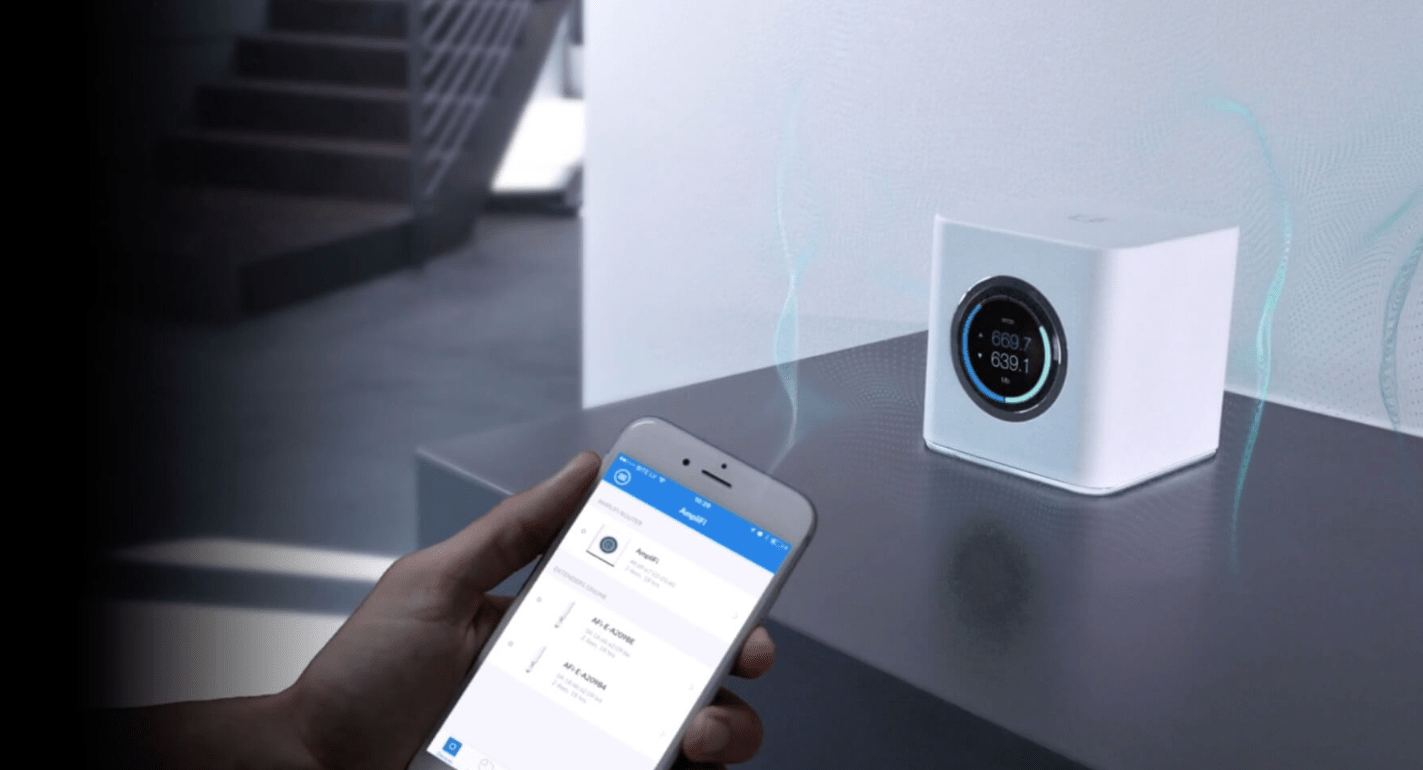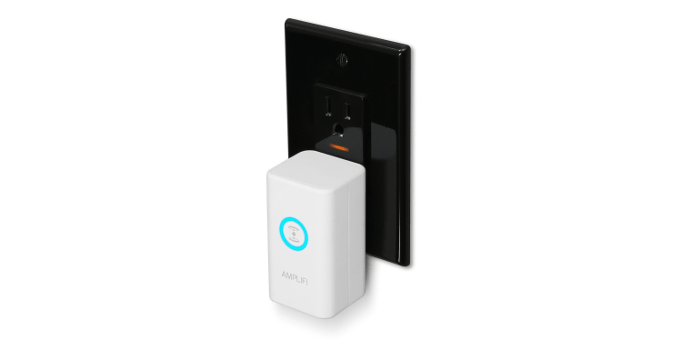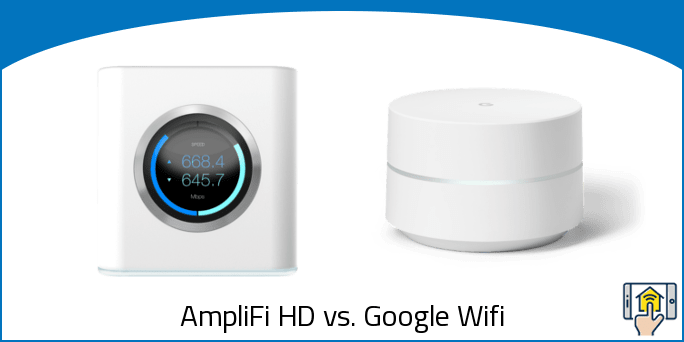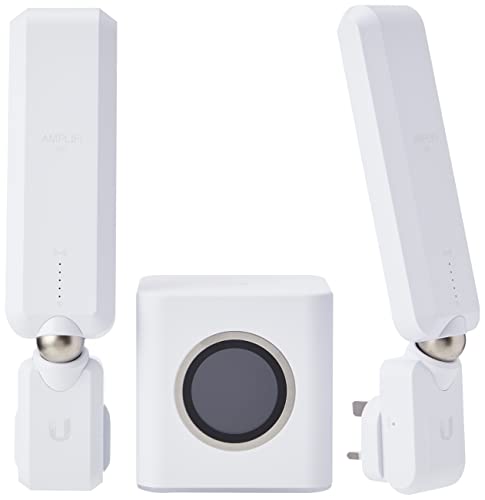With how much time we spend online, it’s becoming more and more important to have a fast and reliable internet connection. The majority of that speed comes from your ISP, but there’s a possibility that your outdated networking equipment is actually holding your connection back.
The routers on the market today are far more advanced than they were even just a few years ago, and it’s possible to lessen or even eliminate a lot of pesky problems like WiFi dead zones or network latency by adding a smart router into your network.
There are a variety of excellent routers on the market, but today we’ll take a look at the AmpliFi HD vs. Google WiFi. We’ll break down the similarities and differences and help give you a sense of what each router has to offer, so you’ll be armed with the appropriate information when it comes time to buy.
AmpliFi HD vs. Google WiFi — Differences

-
Difference #1: Wired Connectivity – There’s a pretty significant difference in the way that each router approaches wired connectivity, and there are advantages and drawbacks to both systems.
First, the AmpliFi HD. The Router itself has 4 Gigabit LAN ports and 1 WAN port. The WAN port is for connecting to the Internet, so you’ll have access to 4 LAN ports with which you can hook up various wired devices. Additionally, there’s a USB 2.0 port on the back of the router, although it’s currently deactivated. The USB port is included for future use. You’ll be able to configure devices to your network with it. There’s also a USB-C power port rught next to the USB 2.0 port.
The main disadvantage to the AmpliFi system is that the HD Mesh points that expand your network don’t have any ports on them at all. This means that all of your wired connections will need to be at least somewhat close to the main router if you want to avoid stringing ethernet cables across the entirety of your home.
The Google WiFi units only have two Gigabit ports, which means you’ll only have access to one LAN port on the router itself. However, where Google pulls ahead of AmpliFi is in its inclusion of an additional two ports on every WiFi point. This means that it’s possible to get a hardwire connection set up in any room that houses a Google WiFi port — even if it’s on a completely different floor than your main hub.
The ethernet ports and the USB-C power port are located on the bottom of the device in a large cavity. You’ll also find a USB port, and just like on the AmpliFi, it’s actually inactive — rendering it pretty much useless for now.
The ethernet capabilities of the Google WiFi have an added perk for those who already have some cables installed in the home as well. There’s a useful ethernet backhaul feature that can be enabled that will allow your devices to communicate with less latency and free up additional bandwidth for your various connected devices.
All in all, we feel that the Google WiFi is the superior device for those looking to take advantage of ethernet connections. The additional ports on the WiFi points are just too good to pass up, and those put the router ahead of the AmpliFi. Add to that the support for ethernet backhaul, and it’s clear that Google has the edge for those who plan to take advantage of multiple LAN connections.
-
Difference #2: Range – While the Google WiFi router might have the edge when it comes to wired connectivity, the AmpliFi is clearly superior when it comes to range.
Ubiquiti is a commercial manufacturer first and foremost, and their powerful technology is readily apparent in their residential applications as well. From a single base and two satellites, the AmpliFi HD boasts an incredible 10000 square foot square range. This blows the Google WiFi’s range — and pretty much all other smart WiFi routers’ capabilities, for that matter — out of the water.
This huge range is reason enough for some people to buy, as it opens up some great opportunities for beaming reliable WiFi to your workshop or outbuilding (or perhaps sharing your signal with a trusted neighbor.)
AmpliFi is able to accomplish this impressive feat due to the way that their satellites are designed. Rather than a compact puck or tower that is intended to sit on a counter or table, the satellites are a tall, two-piece wand that you plug directly into the outlet. This makes them difficult to hide and it might be difficult to fit the device into your room’s decor, but that’s a worthwhile tradeoff in our opinion for the huge distance the router is capable of covering.
The Google WiFi router, while not quite as impressive, still covers a good distance. The type of coverage you’ll get depends on the number of units you have installed.
One node is enough to cover a small home or apartment of 500-1500 square feet. For a medium home of 1500-3000 square feet, you’ll need to upgrade to two units. For large homes of 3000-4500 square feet, three units will get the job done nicely and send a strong connection to every inch of your property.
-
Difference #3: Hardware – The AmpliFi HD might have more impressive range, but the Google WiFi is the more powerful router overall — and by a pretty significant margin.
The AmpliFi processor is clocked at 750MHz, and it features 128MB of RAM and 32MB of flash storage. The Google WiFi, on the other hand, features a Quad-Core ARM CPU, with each core clocked up to 710 MHz. Add on 512MB of RAM, and 4GB of flash memory, and you have a router with an impressive amount of horsepower.
Both routers are built upon the Qualcomm Atheros platform, but it’s easy to see that the Google WiFi is the more capable device with the quad-core setup.
All in all, the AmpliFi HD manages to do a great job with the technology that it has available — even managing to transmit a signal significantly further than Google WiFi is capable of. However, the Google WiFi is clearly the more powerful device. That doesn’t necessarily always translate to a faster or more stable network, but it can certainly help!
-
Difference #4: Smart LCD Screen – Sometimes it’s nice to be able to check on the status of your network without pulling out an app, and the AmpliFi HD’s smart LCD screen lets you do just that.
The sleek and sophisticated design has a small touchscreen at the base, and the display makes it easy to monitor network speeds and view statistics and other information relevant to your network. The screen also tells the time, which makes it an excellent substitute for a desk clock. The AmpliFi router is attractive enough to display prominently rather than trying to hide it, and the touch screen gives a touch of class and some extra utility to a room. The touchscreen also replaces the status lights that you’d see on a traditional router — trading flashing lights for a sophisticated readout.
The Google WiFi does not offer any analogous feature, which puts it at a slight disadvantage when it comes to getting quick information about your network at a glance.
-
Difference #5: AmpliFi Teleport – There are a lot of smart routers on the market that all have various pros and cons, but for the most part they set out to accomplish the same goal of creating a stable, fast, and convenient network. The AmpliFi HD is pretty unique in that you have the ability to purchase an optional add-on called the .
This handy device is essentially a portable VPN that will allow you to use your home internet connection and access all of your devices — even if you’re thousands of miles away from home. While the Teleport does not provide internet service itself, it allows you to use a public connection — such as at a cafe or airport — while affording the same security and convenience that your network back home allows.
No products found.
To put it simply, when you bring the AmpliFi teleport along with you when you’re out and about, you’ll no longer have to worry about network security. Rather than relying on a public network where hackers could potentially be spying and trying to access your information, you’ll be using the wireless signal to browse as if you were home in your office.
The VPN disguises your traffic and makes it appear as if you’re accessing sites from where your AmpliFi network is set up, so it also allows you to do cool things like access region-locked content such as local news broadcasts and sports games while on vacation.
Just hook up your AmpliFi HD router at home, and bring your Teleport with you wherever you go. Never be left without access to your files again, and enjoy a safe browsing experience without putting your device or data at risk.
The Google WiFi router doesn’t offer anything quite like it.
-
Difference #6: Design – There are also some differences in the way that the routers are designed. They are around the same size at 3.9 by 3.9 by 3.9 inches for the AmpliFi and 4.1 x 4.1 x 2.7 inches for the Google WiFi, but the similarities stop there.
The Google WiFi system consists of three identical units — each enclosed in a cylindrical case that is covered by a white, glossy finish. Each device is also sort of cut in half horizontally to leave room for a narrow LED light that encircles the case almost completely. It’s pretty compact so it should be easy to fit it in in pretty much any room, but it’s hefty enough at 12 ounces to avoid toppling over when hooked up to ethernet cables. While it’s easy to hide, it’s also pretty attractive with a beautiful cream color and simplistic design that shouldn’t clash with the rest of the room.
The AmpliFi HD’s design is pretty unique as far as routers go — largely due to the design of the Mesh Point satellites. The main router is a square box with a matte white finish and softly rounded corners, and the satellites are large antennas that plug into an outlet. The design has its benefits and drawbacks. While the main router is pretty inoffensive and even looks impressive enough to be a decoration or clock on its own, the satellites are bulky and difficult to hide. It will be pretty apparent that you have a satellite plugged into your outlet, as they are pretty large. However, the plus side is that you won’t have any table or counter space occupied by satellites.
AmpliFi HD vs. Google WiFi — Comparison Chart
| Ubiquiti AmpliFi HD | Google Wifi | |
|---|---|---|
| WiFi Connectivity | Dual-band WiFi radios, Simultaneous 2.4GHz and 5GHz IEEE 802.11 a/b/g/n/ac |
Dual-band WiFi radios, Simultaneous 2.4GHz and 5GHz IEEE 802.11 a/b/g/n/ac |
| Wired Connectivity | 1 Gb WAN; 4 Gb LAN; 1 USB 2.0; 1 USB-C |
2 Gb WAN/LAN per unit |
| MU-MIMO | No | No |
| Beamforming | Yes | Yes |
| Bridge Mode | Yes | Yes |
| Parental Control | Yes | Yes |
| Security and network services | WPA2-PSK | WPA2-PSK |
| Reduces WiFi Dead Zones | Yes | Yes |
| Range | 1 Router + 2 Satellites 10,000 sq ft |
One 500-1500 sq ft Two 1500-3000 sq ft Three 3000-4500 sq ft |
| Processor | 750MHz | Quad-core 710 MHz |
| Memory | 128MB | 512MB |
| Storage | 256 MB | 4GB |
| Subscription | No | No |
| Dimensions | 3.9” x 3.9” x 3.9” | Diameter: 4.1” Height: 2.7” |
| Color | White | White |
AmpliFi HD vs. Google WiFi — About
The AmpliFi HD router is manufactured by Ubiquiti — a networking equipment specialist that traditionally focused entirely on commercial and enterprise solutions. The brand saw the massive potential that the residential space has to offer, however, and now you can get that same excellent technology that was used for big businesses right in your own home.
Ubiquiti was one of the earlier manufacturers to see the potential of the domestic mesh WiFi system, and the AmpliFi HD remains one of the best routers on the market with a uniquely-designed setup that stands out from the competition.
The Ubiquiti AmpliFi product line is made up of the AmpliFi HD Mesh Router, AmpliFi MeshPoint HD, and the AmpliFi Teleport. The Mesh router can be used either as a stand-alone router, or combined with identical systems in order to provide multi-hop, self-healing WiFi across the entirety of your home.
The AmpliFi MeshPoint HD is an adjustable super antenna that can be paired with the AmpliFi router in order to extend the coverage of your network or turn an existing router into a powerful mesh system.
The AmpliFi Teleport is a truly unique portable VPN that allows you to take your home network on the go — affording you increased privacy and security as well as access to your various files and programs from wherever you happen to be.
The various AmpliFi products work well together, and it’s possible to get great service using just one or an enhanced experience using everything that the family has to offer.
The Google WiFi router works a little bit differently than a traditional router. You’ll set up multiple points in different rooms of your home, and these points will combine in order to form a “mesh” network that can beam a strong and secure signal over an impressive distance. This mesh network is also the underlying technology that the AmpliFi family uses, so the two smart routers go about providing an excellent connection in a pretty similar manner.
Google WiFi was far from the first mesh network on the market, but they have built a reputation in the industry for affordable, reliable products that just plain work. Instead of relying on multiple routers of WiFi extenders, simply set up a few points and really unlock the full potential of your network.
The mesh network technology isn’t exactly new, and the AmpliFi HD and Google WiFi approach the task of providing a superior WiFi connection from slightly different angles.
AmpliFi HD vs. Google WiFi — Things in Common

Now that we know the differences between the two mesh systems, let’s have a quick overview of what these two routers have in common.
Both routers function to reduce WiFi dead zones. Traditional routers often have trouble beaming WiFi over large properties, and even smaller homes can end up with spotty connections at certain problem areas. Rather than run around the house in search of a good signal, consider upgrading to a WiFi network with the capabilities to eliminate these dead zones and give you the same excellent speeds whether you’re in bed or in the basement.
One thing to keep in mind, however, is that it may be possible to eliminate these dead zones without running out to buy an entirely new router. Apps like Wi-Fi Sweetspots for iOS or Wi-Fi Analyzer for Android can detect your wireless signal and give you an idea of where it starts to drop off. Sometimes just moving your router around a bit can be enough to make your network more consistent and save you some serious cash!
The AmpliFi HD and Google WiFi systems also use the same simultaneous dual-band WiFi (2.4 / 5 GHz) supporting 802.11a/b/g/n/ac. Routers support connections by offering different “bands” that provide a place for your various devices to communicate. Both routers have two bands, which is pretty standard as far as modern routers go.
However, they take things a step further than traditional routers with support for band steering. This feature allows your router to direct connected devices to the band that will provide the best performance. With different frequencies to choose from and a variety of connected devices, the ability of the AmpliFi and Google routers to distribute the load optimally is a big benefit and leads to better speeds and reduced latency across the entire network.
While it’s great to have an intelligent WiFi network, you shouldn’t need a degree in IT to figure out how to get it working. Fortunately, both the AmpliFi HD and Google WiFi routers offer simple app control with intuitive and easy-to-access features.
For AmpliFi, the mobile app allows you to see who’s connected to your network and even gives you the ability to monitor your ISP’s speed and your system’s performance. Setting up guest access to your network is a breeze, and you can get your friends online without ever sharing your password.
The Google WiFi app also allows for really simple network control. Just like the AmpliFi router, you can see which devices are connected, run a speedtest, troubleshoot any issues, set up a guest network, and access a whole host of other features that help you keep your network running smoothly. The app also offers cool perks like the ability to check your internet speed at each WiFi point in the network, as well as the speeds that you’re getting from your ISP.
While most people think of common devices like PCs, smartphones, and tablets when the topic of wireless connections comes to mind, the AmpliFi HD and Google WiFi also offer a great deal of smart home support. The routers support ethernet connections which will allow you to hook up a hub like Wink or SmartThings and get your ZigBee and Z-Wave devices up and running quickly and easily.
Most people are looking for a router to replace their existing setup and bring a more reliable signal to the entirety of your home. But what if you want increased range and features while retaining your existing equipment? There’s some truth to the saying “If it isn’t broke, don’t fix it,” and there are a variety of situations where you might want to keep your existing networking setup up and running — enhancing it with new equipment rather than completely starting from scratch.
The AmpliFi HD and Google WiFi both offer support for Bridge Mode, which will allow the router to act as a mesh WLAN rather than a fully-featured router.
One thing to keep in mind with the Google WiFi, however, is that Bridge Mode only works with a single point. If you have multiple nodes, you’ll be forced to stick in the default router mode. Putting this specific router in Bridge Mode will also remove access to some useful features like Priority device, the ability to edit DNS, and control over WAN settings. You’ll also lose access to Guest WiFi, WiFi speed results in Network check, and the Philips Hue pairing and control capabilities. Another downside is that you’ll lose access to some of the security features since Google WiFi won’t have complete control over your network.
Long story short, both the AmpliFi and Google WiFi offer support for Bridge Mode, but you’re sacrificing a lot of features if you use it with the latter.
Another feature worth noting is parental control. With AmpliFi HD, parents can monitor internet usage on each device individually through their device profiles and can pause the internet, set time restrictions or schedule the internet connection on each device. Google WiFi’s parental controls is pretty much the same. It largely consist of an impressive ability to block inappropriate content. Turning on SafeSearch will automatically block billions of websites, which makes it much easier to keep your kids safe while they’re browsing the web. You’ll also be able to pause Wi-Fi access on demand and schedule internet time-outs.
Last but not least, both routers feature an incredibly simple installation. Getting your network set up should only take a few minutes, and just involves plugging in a few cords and pulling out the mobile app.
AmpliFi HD vs. Google WiFi — Accessories

Both the AmpliFi and Google WiFi devices should work quite well right out of the box, but you do have some options in terms of additional accessories that make setup and daily use a little bit easier.
For the Ubiquiti AmpliFi, the obvious recommendation is the AmpliFi Teleport for access to your home network while on the go. We also recommend pairing the router with the ARRIS SURFboard Modem for the optimal setup for streaming HD Video and gaming on multiple devices at the same time.
The Google WiFi’s accessories are mainly designed with flexible installation in mind. The Google WiFi Wall Outlet Mount, Wall Mount / Ceiling Mount, and Google Router Mounting Bracket all make it easier to get your network setup in a place that is both accessible and convenient.
AmpliFi HD vs. Google WiFi — Our Thoughts

Both AmpliFi HD and Google WiFi look quite elegant and do away with the traditional alien-esque design of a router in favor of a model that could blend in quite nicely on a side table or desk. The AmpliFi HD network falls a bit short here, however, due to the unattractive satellites that are a sharp contrast to the main unit.
What it really comes down to, however, is the performance of the network — and they honestly both do a pretty good job. Support for Ethernet backhaul and better wired connectivity gives the Google WiFi an edge, but the AmpliFi Teleport is equally as useful for those who want constant access to safe browsing and their files at home. Setup is also incredibly easy with both systems, and the mobile apps offer an intuitive and pleasant experience for managing the status of your network.
If you’re looking for exceptional range and access on the go, the AmpliFi HD is definitely the top choice. For those who prioritize hardwired connections, however, the Google WiFi might be the superior choice.
All in all, it’s difficult to declare a clear winner in this comparison. We can confidently say that both routers offer exceptional performance and will fit in quite nicely with your home.
Last update on 2024-04-18 at 10:01 / Affiliate links / Images from Amazon Product Advertising API



